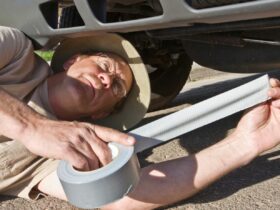Rain has the potential to transform a leisurely camping trip into a test of survival skills. However, armed with effective strategies and thorough preparations, not only can you endure but also flourish despite the damp and challenging conditions. Here, I present seven indispensable tips that will pave the way for a triumphant and rewarding camping experience, even amidst relentless rainfall.
Shelter Building and Site Selection
Choose Elevated Ground:
Opt for a higher campsite to prevent pooling water. Avoid valleys or depressions prone to flooding during heavy rainfall.
Effective Shelter Setup:
Construct a sturdy shelter before the rain intensifies. Set up a durable tent or improvise a shelter using tarps or branches, ensuring a proper rain fly and groundsheet to keep the interior dry.

Firecraft for Wet Environments
Gather Dry Firewood:
Collect ample dry firewood or kindling before the rain starts. Seek wood from the interior of fallen trees or use a knife to split through damp outer layers to access dry wood inside.
Utilize Fire Starters:
Pack waterproof fire starters like lighters, storm matches, or waterproof matches. Additionally, carry cotton balls coated in petroleum jelly or store them in a waterproof container as reliable fire igniters.
Waterproofing Strategies
Protect Gear with Tarps or Plastic Bags:
Cover your gear with tarps or use heavy-duty trash bags to prevent soaking. Double-bag essential items like clothing, electronics, and food to ensure they stay dry.
Seal Tent Seams and Zippers:
Before the rain, apply seam sealant or waterproofing solution to your tent seams and zippers to prevent leaks. Keep the tent door closed as much as possible to minimize water entering.
Clothing and Gear Choices
Layering and Waterproof Clothing:
Wear moisture-wicking base layers to keep your body dry. Over these, use waterproof and breathable outer layers, such as rain jackets and pants, to repel rain while allowing sweat to escape.
Protective Footwear:
Invest in quality waterproof boots or shoes to keep your feet dry and prevent blisters. Carry extra pairs of dry socks and change them regularly to avoid foot-related issues.
Hydration and Campsite Management
Stay Hydrated:
Despite the rain, maintain hydration. Ensure you have access to clean water, either by packing it in or setting up a rainwater collection system. Boil or purify collected water before consumption.
Campsite Drainage:
Create trenches or channels around your campsite to divert water away. This prevents pooling or flooding around your shelter, reducing the risk of dampness.
Mental Preparedness and Safety Measures
Maintain a Positive Mindset:
Stay optimistic and focused on solutions. Embrace the challenges as learning experiences and keep morale high within your camping group.
Safety Concerns and Exit Strategies:
Monitor weather forecasts and be prepared to evacuate if conditions worsen. Establish an exit plan and be ready to implement it if necessary for safety reasons.
Campsite Cleanup and Departure
Dry Out Gear Before Packing:
When the rain stops, take advantage of any breaks to dry out wet gear. Hang clothes, sleeping bags, and tarps to air out before packing them away.
Leave No Trace Principles:
Leave the campsite as pristine as you found it. Collect all trash, properly dispose of waste, and dismantle your shelter, leaving minimal impact on the environment.
Conclusion
Survival camping in the rain demands preparation, resourcefulness, and adaptability. By implementing these tips and techniques, you can not only endure but also thrive in adverse weather conditions. Remember, maintaining a positive attitude and being proactive are key elements to a successful rain-soaked camping adventure.






Leave a Reply